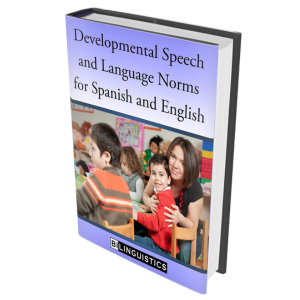There are a few questions that top the list of “most asked” when SLPs are inquiring about which articulation errors in bilingual children they should be treating.
When focusing on articulation errors in bilingual children, we have to consider intelligibility, their age, level of exposure to English, and academic need prior to deciding whether we include the sounds in our articulation goals.
Here we cover the two most common questions and you will see that they not only provide an answer for us but also a framework to evaluate which sounds to target when we work with bilingual students.

Can we work on English Sounds with a Child Who Speaks Spanish?
“I know we don’t initially set goals for sounds that it exist in English, but not in Spanish, like voiced and unvoiced TH or Z, but is there a time where it’s ever appropriate to work on these sounds?”
The answer is yes, in certain circumstances.
Let’s start by saying that this question shows the great strides many in our field have been making to determine if they should or should not be focusing on sounds because of native language influence. Here are a set of considerations that we have to move through before we focus on English articulation errors in bilingual children.
Appropriate Age
Regardless of the home language, would an English-speaking child of the same age be expected to be to produce that sound? If this seems like a no-brainer, good for you! However, we have run into situations where we see sounds being targeted and the child isn’t old enough in either circumstance.
Age of English Exposure
Our sounds in English are laid out youngest-to-oldest, most frequent-to-least frequent, and easiest-to-hardest. So just because a Spanish-speaking child is 8, doesn’t mean he should have the English /r/ unless he has been in the country and practicing with English for several years. Even then, some speakers continue to produce English sounds with influence from their native language, and that’s okay.
Peer Comparison
What do other kids like this child, from the same class or zip code sound like? Do they use the same sounds in the same way? Asking the parents or teachers about how different a child is compared to their peers is a great way to demonstrate what typical development is.
Cultural Acceptability
Basically, do the other kids in his class or neighborhood use this sound? There are sound substitutions such as /d/ for /th/ that are made by everyone in a student’s environment. If this is the case, it is not a good target for special education. Aside from all of the culture implications, there is not a way to practice it successfully outside of speech therapy so it won’t generalize. Also, there is research to suggest that sounds like /th/ might be completely removed from all English speakers by 2066.
Intelligibility
Measure intelligibility. Don’t approximate or guess. Record or listen to the child and count. This is a hard one to accept and an even harder one to defend at times in IEP meetings. But, is the child highly intelligible? On the language side of things, we have no problem dismissing a child with standard scores in the low 80s (average). But on the articulation side, typically we are going for perfection before a dismissal.
Low intelligibility needs to be addressed -yes. With articulation errors in bilingual children however, they are often borrowing an allophonically similar sound from the home language so the sound is similar but not exact. With Spanish, we see this with /r/ quite frequently where the short tap R is used for a variety of English Rs. We also see /v/ to /b/ substitutions and /j/ to /df/ substitutions (/dges/ for “yes”). An easy way to test this out is by having the child imitate you saying the sound in isolation. Most of the time they can produce it but just aren’t using it in conversation.
What we are trying to avoid here, is keeping a child on our caseload for a single sound error that falls more into the camp of accent.
Academic Need
Can the child write the sound that she is saying in error? Can she highlight it every time she reads it in a passage? If so, there might not be academic need.

When to Focus on English Articulation Errors in Bilingual Children
The list above is not a formalized process we go through but more a quick mental checklist of considerations to decide on services. Let me tell you about a child we worked with who came from a Spanish-speaking home where we qualified him for English articulation.
I had been working with Bryan since Kindergarten when he was a 100% Spanish-speaker. He was in a bilingual program and by 3rd grade his English was developing well. I had only been working in Spanish and had cleaned up all of his sounds in Spanish. When I started to talking about dismissal, the teachers were worried about how he was speaking in English.
His parents, being Spanish-speakers, thought his English was amazing considering Bryan did most of the speaking for the family at that point. So what was going on? Running through the thought-process above:
- He had been in the country and practicing English long enough
- He could read and write well
- He was intelligible in both Spanish and English
- Some of the sound errors (/th/) were also produced differently like his peers
- All of his peers could produce /r/, /l/, and /s/ in English. He could not.
Bryan’s /r/ was a /w/. His /l/ was a /w/. His /s/ was lateralized. These all became good targets. I transferred him over to the English-SLP to continue services for 4th and 5th grade.
Typically what I have found is that if I am working on phonology with a bilingual child, the processes are present across all languages. If I am working on articulation with a bilingual child, they are typically in 3rd grade or older and have the expected difficult sounds as their goals. Maybe there is a 1st and 2nd grader with some velar stuff going on. But it is typically the older kids. We put together some developmental norms specific to Spanish that you can see in this essay.
On to the second most common question asked about articulation errors in bilingual children.

Should the Rolled R or Trilled R be an Articulation Goal for Spanish-Speaking Children?
“I’ve got a student that is about ready for dismissal but he can’t trill his R. The (bilingual) teacher and parent are not wanting him to be dismissed until this is fixed. Should I keep him on my caseload?”
The answer is, no. For many reasons. Let’s hop through them using your new knowledge from above.
Intelligibility
Not an issue usually. Students who can’t trill their R use a tap-R typically.
Educational Need
None.
Peer Comparison
While most of his peers can probably trill their Rs, it is not true for the entire Spanish-speaking population. So bilingual people out there put your seatbelt on. There are native Spanish speakers who can’t trill their Rs. There are areas that trill their Rs but the use is declining, such is in Bogotá.
There are dialects that don’t trill their Rs such as in Costa Rica.
Would a Spanish speech therapist (logopeda) target rolled R in a monolingual Spanish-speaker in a Spanish-speaking country? Yes, probably. But, targeting rolled Rs as articulation errors in bilingual children doesn’t meet the criteria of academic need or intelligibility.
I will go as far as to say that if you have other sounds you are working on, the double R can be targeted. However, not if this is the only goal you have left.

Identify Appropriate Articulation Targets for Second-Language Learners
Improve articulation therapy with English-language learners by identifying appropriate targets. Easily use common tools such as Venn Diagrams and the Goldman-Fristoe Test of Articulation to differentiate between true sound errors and second-language influences. In this presentation we will use Spanish as an example to explore how sounds develop when a second language is present.



